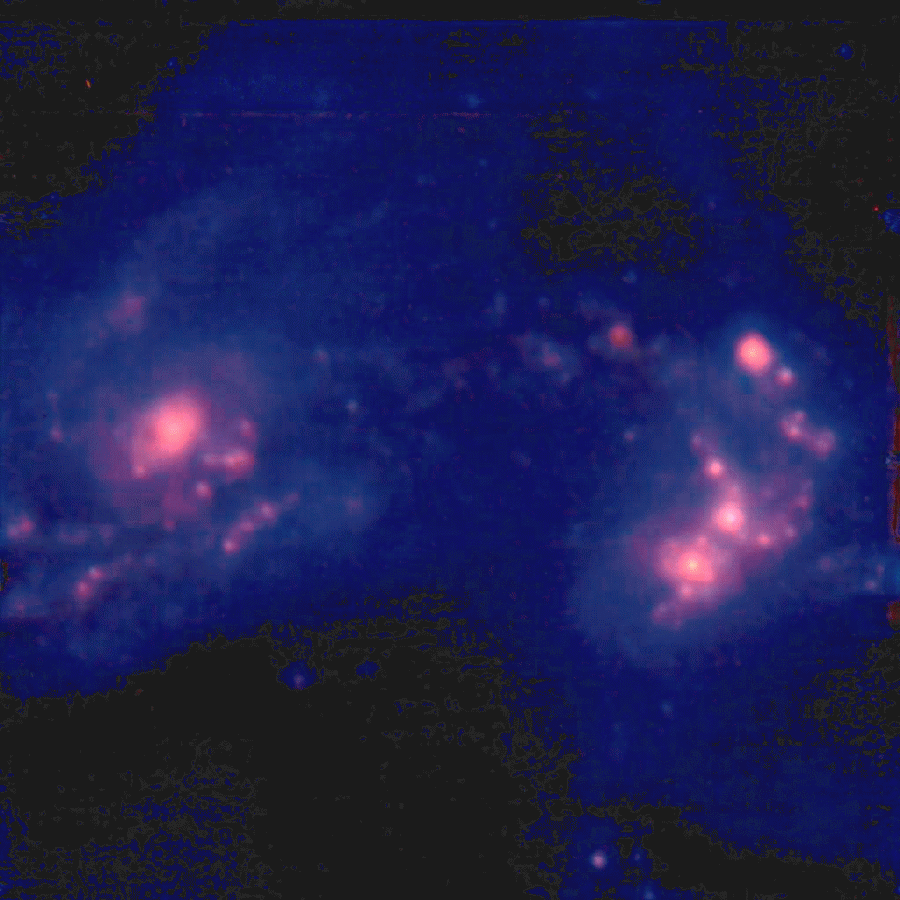
A Close Look at Arp 299
Credit: Image courtesy of O. Lai¹ & D. Rouan²
¹Canada-France-Hawaii Telescope Corporation
²DESPA, Observatoire de Paris, France
(for more details see: Lai et al., 1999, Astronomy & Astrophysics, Vol. 351, p. 834-840)

Our Sun is located somewhere in one of the spiral arms of our Galaxy,
the Milky Way. Our Milky Way itself is surrounded by other galaxies,
like Andromeda (see the image of the week of Dec 6th, 1999 for example). These form what
we call the Local Group. But somewhere out there, farther out, there
are millions of millions of other galaxies and some of them are
extraordinarily luminous, especially in the infrared, emitting more
than one thousand billion times the luminosity of our Sun!!!
For comparison, our Galaxy which is a normal but fairly large galaxy emits
at least one hundred times less...
These amazingly bright objects, called Ultraluminous Infrared
Galaxies were discovered by the IRAS
Satellite. Their geometry is in general complicated, resulting for
interactions and/or collisions with other galaxies.
Understanding them still poses a challenge to the astronomers. For
example, where do they take their energy from? A hidden new-born
Quasar or an extreme flash of star formation? A group of French
astronomers have recently used the CFHT to image Arp 299, one such
Ultraluminous Infrared Galaxy. As expected, Arp 299 is a
merging galaxy, i.e., two galaxies colliding together. An optical
image showing this interaction (extracted from the NGS/Palomar Sky
Survey) can be seen here. Arp
299 is also known as NGC 3690 or Mkn 171 A & B. One of the authors'
images, is shown as this week's image. The
most striking result is that Markarian 171 A, at left and the most
active source of the merging system, appears elongated in the near
infrared, at 2.2microns. This result likely rules out a new-born
Quasar as the energy source because a Quasar would be too small and
would remain unresolved. On the other hand, an intense zone of star
formation is expected to be more extended and resolved, as detected on
the image. Also, the high angular resolution provided by PUEO allowed
to image and confirm the starburst nature of numerous other zones of
intense star formation located in Mkn 171 B, on the right hand side on
the image. They are seen as bright red knots.
All these results support the idea that a flash of star
formation is the power source for the extremely bright Arp 299.
Technical description:
This is a color-composite mosaic image that covers a square area of 40
arcsecond on a side. The individual frames were obtained on December
14-17th, 1997, with PUEO,
the adaptative Optics Bonnette, attached to the Canada-France-Hawaii
telescope. The images were obtained in the near-infrared part of the
electromagnetic spectrum, with the KIR
camera.
The individual frames were obtained in two filters: the J and K bands
at 1.25 and 2.2 microns, respectively. 4 images of 600sec make the
final J image, and 8 images of 200sec were obtained in K-band. Here in
the final color-composite image, J-band is coded in blue and K-band in
red. The "blue" zones are brighter at J and trace the stars we see
unobscured. The light from object burried deeper inside Arp 299 is
absorbed. The K-band is more appropriate to probe deep inside and the
embedded active star forming regions are brighter in K and color-coded
in red here. The individual J and K images are shown in
this panel for comparison.



